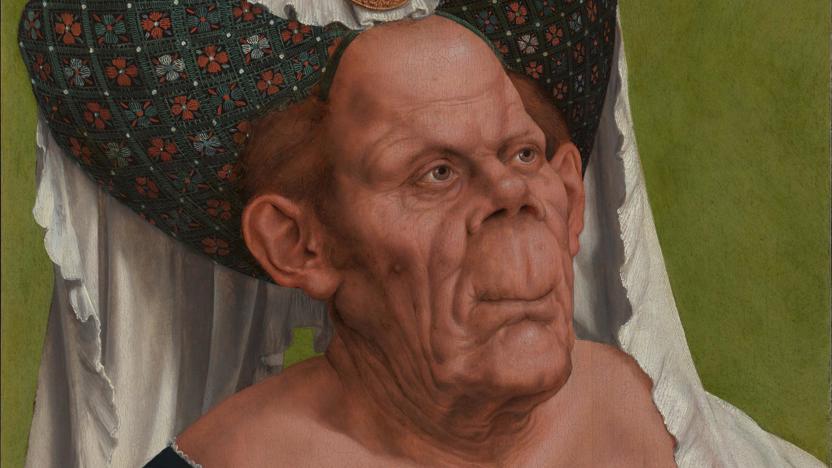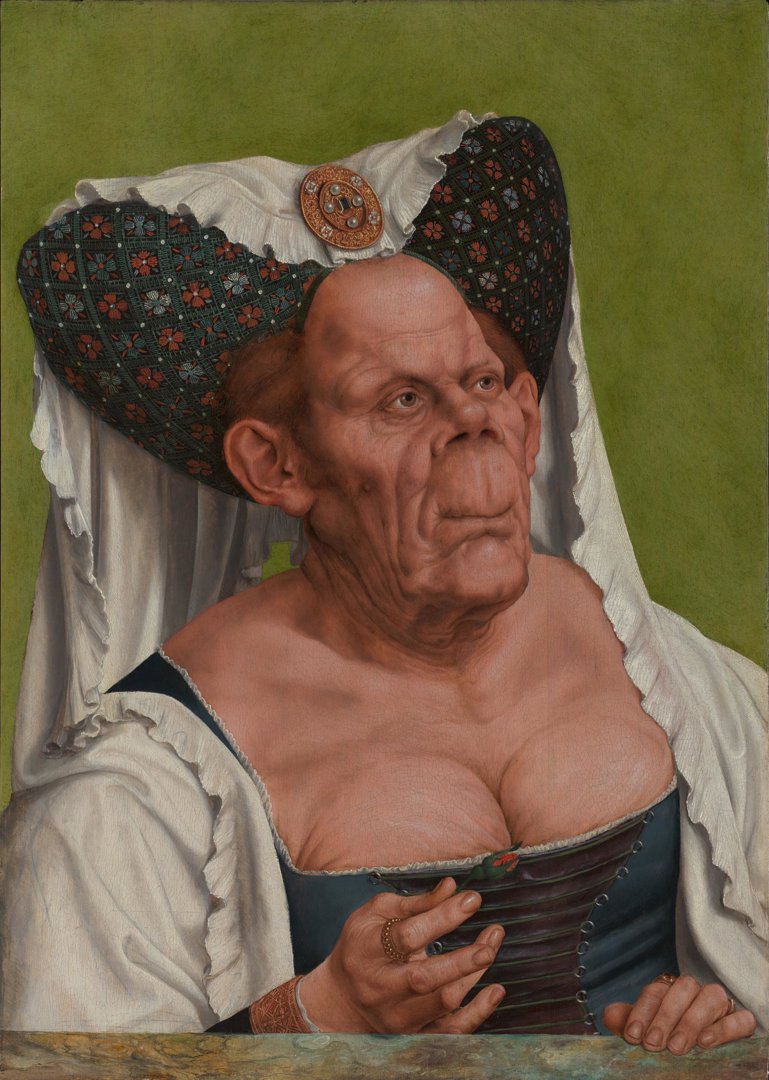Quinten Massys's 'An Old Woman'
Audio description
This is a description of the painting 'An Old Woman', also known as 'The Ugly Duchess', painted around 1513 by Quentin Massys. It is oil on canvas, just over 60 centimeters high and 45 wide, in a simple dark brown frame.
This detailed and vibrant portrait is of an elderly woman. It shows her from just above the waist up, wearing a substantial, elaborately embroidered horned headdress. Her remarkable face, with its extreme and unusual features, is set against a bright green background.
She is turned three-quarters of the way to the right, has small lively brown eyes focused intently on something high up to our right. Running along the bottom is a marble ledge, her wrinkled hands resting on it.
The woman's strong-boned face is not what we are accustomed to in portraits of this era. She is not an idealized version of delicate beauty, a goddess, or a queen. Richly dressed, she defies the modesty expected from older women during the Renaissance by wearing a low-cut, tightly laced bodice, which pushes up her breasts to create a wrinkled cleavage.
The woman's pink-skinned face is wrinkled, wide ears fanning out beneath the red wispy hair at her temples, the rest of her hair covered by her headdress. A prominent hairy mole perches on her right cheek. She has a domed, shiny forehead, thin eyebrows, and sparse lashes. Her nose is high up on her face, with large nostrils, and her long face stretches down to a prominent square chin. Her colorless lips pucker, suggesting she has lost her teeth. Sagging jowls ripple down to swollen neck glands above her wrinkly cleavage.
Her elaborate embroidered horned headdress is dark and dramatic, in rich blues and greens, covered in a lattice of small white, red, and blue flower motifs. Massys has painted each stitch in detail, showing the texture of the fabric. A white cotton veil is pinned to the center of the headdress with a considerable gold brooch. It is round, studded with four pearls and assorted jewels. The veil itself hangs behind the horns of the headdress and drapes over her shoulders on either side, framing her with the folds of its ruffled edging.
She is wearing a dark blue dress, the bodice tightly laced over a darker central panel, and edged with a thin white frill. Beneath the thumb and forefinger of her right hand, she delicately holds a red rosebud, a symbol of love, youth, and sensual possibility.
We do not know the identity of this woman, although Massys' extraordinary rendering brings her to life, as if at any minute she will open her lips and speak. There has been speculation that Massys has painted a woman who has Paget's disease, a condition which causes facial differences. Another theory is that she is a character from the world of folklore and carnival. This kind of lavishly dressed old woman also features in several prints, miniatures, and church carvings of the period. The painting may well have been paired with that of an older man, now in a private collection in New York, but we have no documentation to prove this. It is clear, however, that she was an object of fascination for the artist, who, like his contemporary Leonardo da Vinci, was intrigued by those with extreme and unusual features. Both artists made a large number of sketches and prints of people which they called grotesques, which were popular with the public at the time.
In the 17th century, the painting was misidentified as a portrait of Margaret Maultasch, Duchess of Corinthia and Countess of Tyrol, named by her enemies as the ugliest woman in history. On this basis, the painting gained the nickname The Ugly Duchess. In the Victorian era, it inspired John Tenniel's depiction of the Duchess in his illustration of Lewis Carroll's Alice's Adventures in Wonderland. This entrenched the moniker and turned this figure into an icon for generations of readers.


